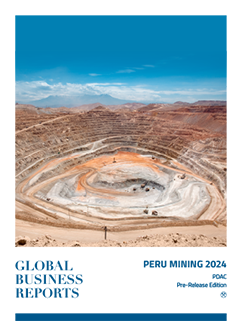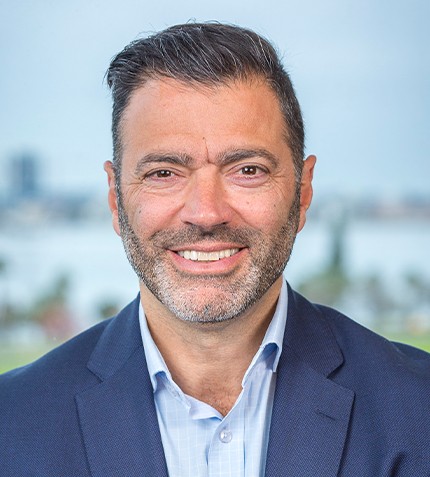Mining Prevents GDP Contraction
RELATED PUBLICATION
ARTICLES FROM THIS PUBLICATION
Peru: Calm after the storm

Image courtesy of Minsur
The situation in Peru during early 2023 was marked by social chaos, impacting a significant portion of the mining industry. Amidst various messages about attempts to advance elections, President Dina Boluarte decided in June to remain in office until 2026.
As 2023 unfolded, reports suggested that the Democratic Republic of Congo (DRC) had overtaken Peru as the world’s second-largest copper producer. Meanwhile, Quellaveco, operational since 2022, was the last greenfield project to be developed in Peru, where no similar new projects are on the horizon.
However, in February 2024, the Peruvian mining industry breathed a sigh of relief when the Ministry of Energy and Mines (MINEM) announced that copper production in 2023 reached 2.75 million t/y, a 12.7% increase from 2022. This record was driven by Quellaveco’s output and the uninterrupted operation of MMG’s Las Bambas since the second quarter of 2023. According to the MINEM and the USGS’ Mineral Commodity Summaries 2024, Peru remained the second-largest copper producer, with the DRC producing 2.50 million t/y.
This news is significant, especially considering the importance of being the world’s second-largest copper producer in the eyes of investors. The mining industry contributes 11% to Peru’s GDP and private investment, a significant figure given Peru’s global macroeconomic context.
In addition to political turmoil, the effects of El Niño, Cyclone Yaku, a monetary policy fighting inflation, and weak international growth have taken a toll on the Peruvian economy. According to the latest data attributed to INEI, most productive sectors have had a negative contribution to Peru’s GDP growth, except for mining, which was positive, highlighting the importance of the industry for the country. As former Economy and Finance minister Alex Contreras said in the “Jueves Minero” forum oorganized by the Peruvian Institute of Mining Engineers in December 2023: “2023 has been one of the most difficult years of the last two decades, leaving aside the pandemic […] Without mining, this small recession would have been worse.”
The events of 2023 have caused investors to look for other regional options, and many are waiting to see what happens in 2026, an election year. When a country has an active pipeline with progressing projects, two years, in mining terms, is ephemeral. For Peru, two years is an opportunity to lose without new projects on the near horizon. “I believe that everything that transpired during 2023 has significantly undermined business confidence for investment, and this is reflected in a substantial decline in investment across various sectors, particularly in the mining sector,” commented Marcial García, partner at EY.
While it is true that there is a more positive atmosphere amont C-executives this year compared to 2023, one cannot help but wonder if the country is in a bubble where the prevailing status quo could burst at any moment.
For it to burst, many factors would have to align. Nevertheless, the industry should not overlook this period of apparent tranquility: It must advocate for comprehensive national mining policies that transcend the current administration: “We need a leader in the Ministry with a deeper understanding of the mining sector to capitalize on its potential and to find mechanisms beyond permitting to promote the industry. We need a minister capable of working with various public and private entities to comprehensively address the problem of illegal mining. Action must move beyond speeches and announcements to concrete measures,” declared Víctor Gobitz, president of the National Society of Mining, Petroleum, and Energy (SNMPE).
On February 13th, Rómulo Mucho was appointed Minister of Energy and Mines following a reshuffle in Boluarte’s cabinet. Mucho, who served as the vice minister of Mines from 2005 to 2006 and has established connections with the industry, will bear the responsibility of bridging the gap between the private sector and the government in the forthcoming months. His role will be pivotal in fostering mutual understanding and aligning their views for the country’s best interest.
The one-stop shop initiative
Óscar Vera, minister of Energy and Mines until February 2024, faced various challenges that affected the Peruvian mining and its attractiveness to investors. One of the main issues was permitting.
Peru boasts significant potential for substantial discoveries and the development of new mines, as demonstrated by projects like Mina Justa in 2021 and Quellaveco in 2022. However, the current government must implement measures to expedite permitting processes and streamline the existing project pipeline.
In recent months, the former head of MINEM appeared to have listened to the industry and, after working with the Executive Branch, who launched the “Plan Unidos” to reactivate the economy and boost the productive sectors, managed to include within the 25 measures a release of mining projects worth US$4.64 billion for 2025 and US$4.65 billion for 2026. Among these projects, we find the short-term extensions of Antamina and Toromocho (US$2.41 billion), Yumpag, Romina, Corani, and Chalcobamba (US$964 million), and Zafranal (US$1.26 billion). Some of these projects have already obtained their respective permits. For example, Zafranal has received its Environmental Impact Assessment (EIA) approval. However, others, such as Corani and Romina, require their respective companies to address financial concerns before progressing with the project.
On the other hand, in February 2024, MINEM announced the launch of the ‘digital one-stop shop’ (VUD). Under this system, different widespread entities, like Senace, Ingemmet, and the Ministry of Culture, will work together to meet the deadlines for the approval of permits and reduce a period that currently takes two years to six months.
The launch of the VUD seems to be a positive signal for the industry. Various stakeholders along the value chain are seeking not to lower international standards but to reduce timelines while adhering to the existing robust standards: “While the existing permitting process is robust and methodical, the key factor is time. Acknowledging the importance of time efficiency, a streamlined process can significantly benefit junior mining companies and expedite the realization of projects,” commented Jay Chmelauskas, president and CEO of Camino Corporation.
It is impossible to predict whether the implementation of the VUD will effectively reduce the current delays in permits. Still, it is a positive sign that the current government has been responsive to the industry’s concerns in recent months.
Illegal mining vs artisanal mining
To claim that the relationship between local communities and mining has improved would be inaccurate; it remains delicate. According to the Peruvian Office of the Ombudsman for the Prevention of Social Conflicts and Governance, as of December 2023, two thirds of the 134 active socio-environmental conflicts were mining-related, a percentage that is in line with 2022 figures as well. The toll of some of these conflicts is severe: In December 2023, a group of illegal miners attempted to seize control of Minera Poderosa’s operations in Pataz, killing nine security agents by detonating multiple charges of ANFO (high-powered explosive) in one of the underground galleries of the mine. More recently, in January 2024, illegal miners brought down a high-tension tower that supplies power to the operations.
Based on information from the Financial Intelligence Reports (IIF) by the Superintendence of Banking and Insurance (SBS), in their Financial Intelligence Unit (UIF) report of June 2023, illegal mining is the crime worth the highest accumulated amount, reaching US$8.2 billion, surpassing drug trafficking, which amounted to US$640 million.
In addition to the “synergies” among illegal mining and other illegal activities, which affect the sector’s image, illegal mining has several environmental consequences, such as the indiscriminate use and disposal of mercury for gold recovery. Since illegal miners do not adhere to the regulations proposed by the government, unlike formal mining, illegal mining operations often neglect environmental safeguards.
Addressing illegal mining is a complex challenge. According to Marcial García, partner at EY, when informal mining emerges, there is no clear response, especially from specific leftist sectors that oppose formal mining activities due to environmental risks: “The lack of control has allowed these illegal activities to grow, even infiltrating certain power structures, backed by lobbyists who hinder necessary legislative changes,” he explained.
The most delicate aspect in relation to illegal mining is its impact on Artisanal and Small-Scale Gold Mining (ASGM), particularly in terms of public perception. Unlike illegal mining, ASGM is legal and adheres to environmental standards. According to the World Gold Council, ASGM is among the fastest-growing rural livelihoods in numerous developing countries. Various reports from the UN Environment Programme and the World Gold Council suggest that ASGM contributes between 15% and 25% of the world’s gold. However, this practice is often overshadowed by the prevailing perception of environmentally unsound extraction methods and the association of such activities with illegal mining.
In Peru, specific figures regarding ASGM’s contribution to the national gold output are not explicitly outlined by the MINEM. Nevertheless, Jean Martineau, president and CEO of Dynacor Group, observed its considerable impact: “It is estimated that between 22% and 24% of annual gold production comes from these miners, a significant percentage that continues to increase, unlike the conventional mining sector.”
Dynacor is one of the few companies in Peru focusing on ASGM. To ensure that the gold they export to Switzerland does not originate from illegal mining, the Peruvian government requires the company to guarantee the traceability of gold to its origin. Additionally, according to Martineau, Dynacor adheres to rigorous due diligence when admitting new miners: “We set compliance standards with 25 points that we check thoroughly. We maintain constant oversight of these criteria each time a miner returns, ensuring that they are met continuously,” he concluded.
Peru has been trying to formalize several informal mining operations through the Reinfo (Integral Mining Formalization Registry). However, for Víctor Gobitz, president of the SNMPE, the Reinfo is not enough: “The solution does not lie solely in the Reinfo but in designing a broader and deeper strategy in collaboration with the government. It is necessary to understand the entire production chain and find ways to formalize it gradually, recognizing the complexity of the problem and avoiding social upheaval,” he said.
The government has a lot of work ahead for 2024. It is crucial to continue efforts to streamline permitting procedures, where specific progress has been made, and address illegal mining. Considering the significant financial gains linked to this activity, there seems to be a tendency to focus primarily on formal mining operations adhering to strict national and international standards, thus increasing the pressure these companies face.











